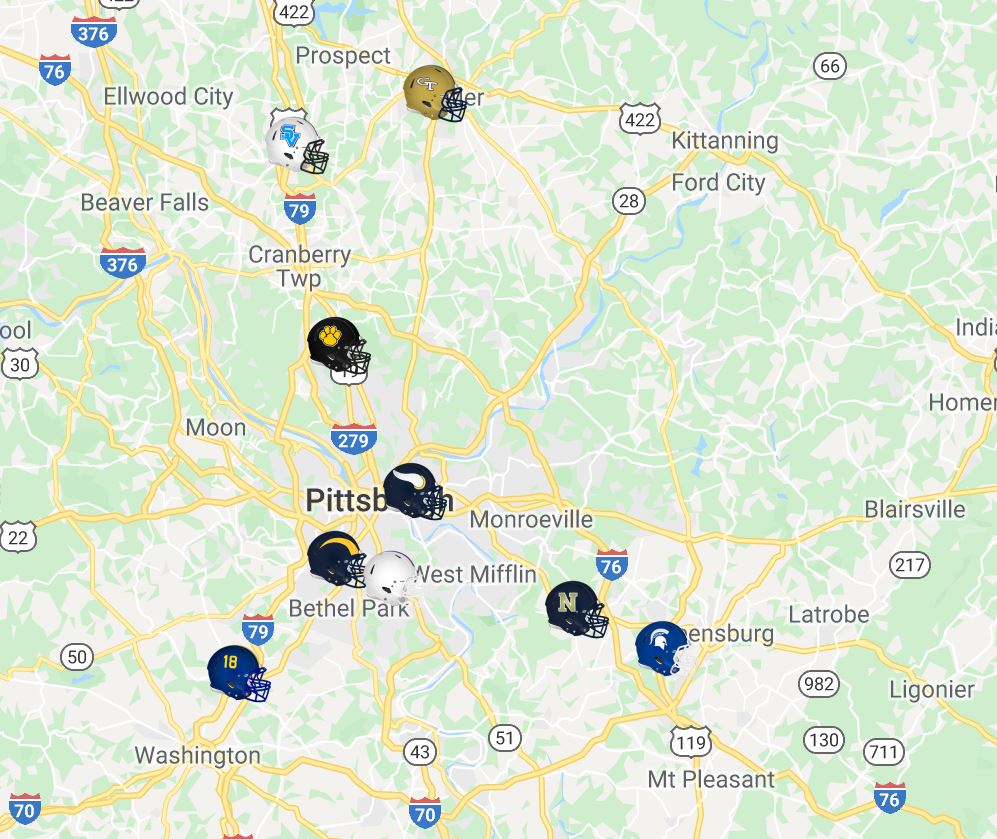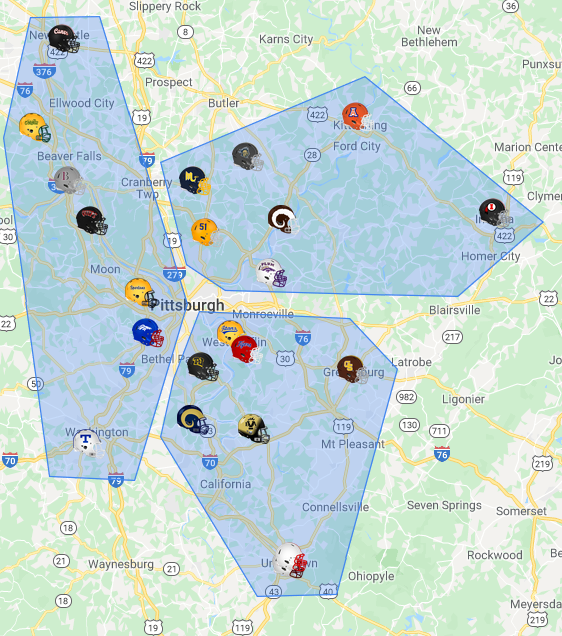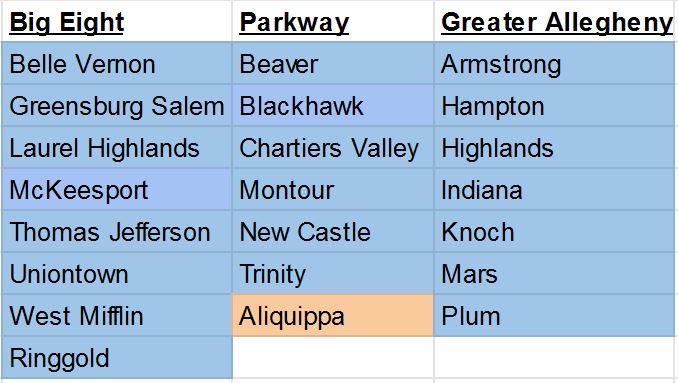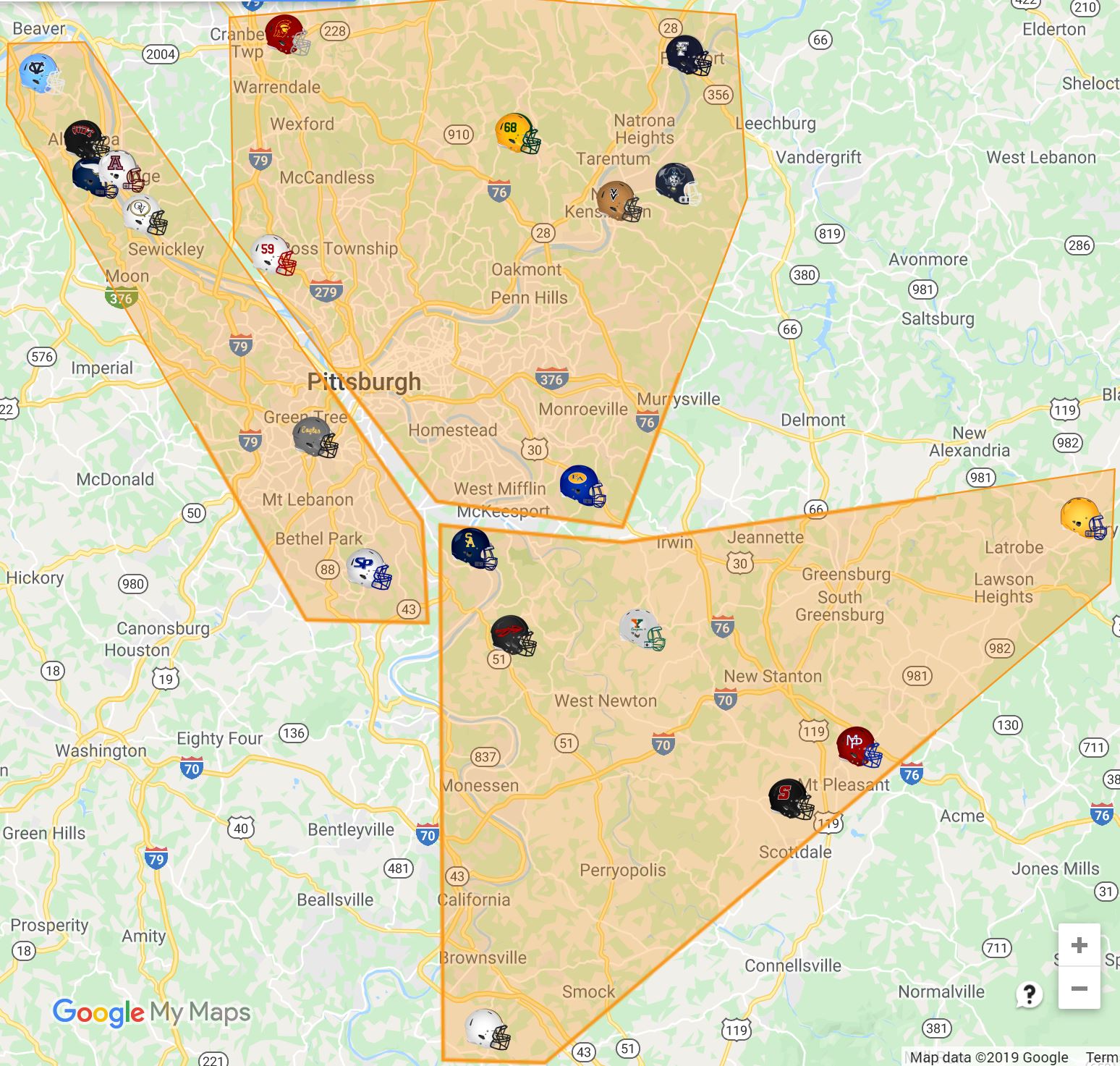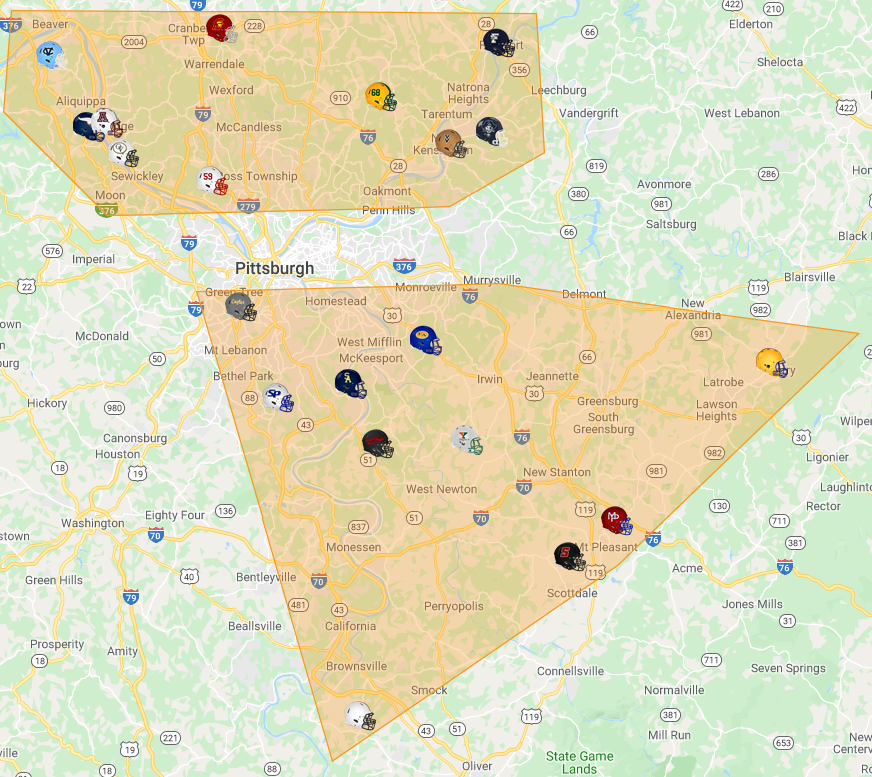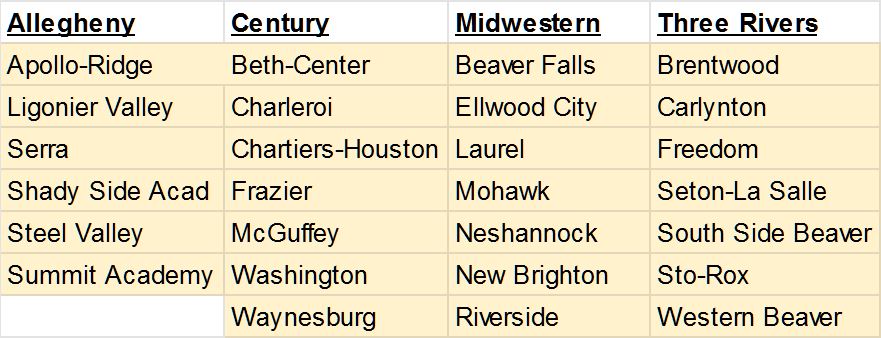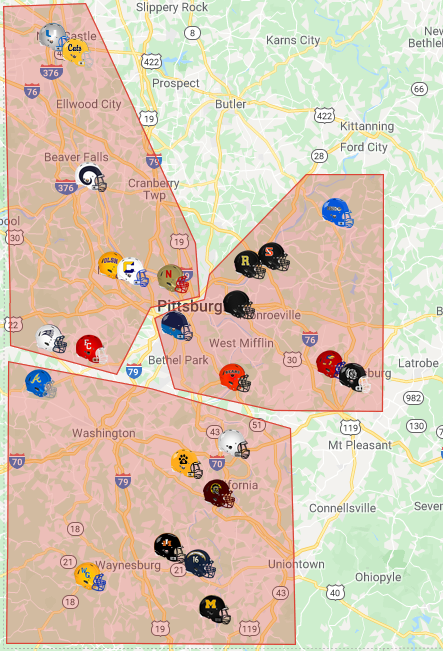With the 2019 high school football season wrapping up this past weekend with the State Championship games, attention now turns to the next alignment cycle. Every two years the PIAA realigns classifications in all sports. To do so, all 570 football-playing schools across the state submit their enrollment numbers (9th-11th grade boys). The PIAA organizes teams from largest to smallest statewide based on enrollment, with the largest 1/6th playing in 6A, the next 1/6th playing in 5A, and so on. Teams are assigned to classifications for a two-year cycle. Based on the reported enrollment figures, it seems this cycle will once again have only 9 WPIAL teams in 6A. In the rest of the WPIAL, Class 5A will have 18 teams, 4A will have 21 or 22 teams (depending on Albert Gallatin), 3A will have 21 teams, 2A will have 27 teams, and 1A will have 24 or 25 teams (depending on Vincentian).
This will be the third cycle of the six classification system, which the PIAA moved to in 2016. With the 6 classifications in place, the next decision for the WPIAL board to make is the alignment of conferences and playoff structures. First and foremost, the PIAA playoff schedules dictate a portion of the WPIAL schedules. The PIAA decides at what point the champions from each district enter the state playoffs.
For example, in the last two years the WPIAL Champions from 4A, and 6A entered the state playoffs at the quarterfinals which meant their Championship Games had to take place in Week 12. WPIAL Champions from Classes 1A, 2A, 3A, and 5A entered the state playoffs in the semifinals. However, because the WPIAL wanted to have 4 Championship Games at Heinz Field, 1A and 3A had just 8 teams make the playoffs with the title game in Week 12. Those champions received Week 13 off before the PIAA semifinals.
Depending on how the PIAA sets up their playoffs and at what point the WPIAL Champions enter the state playoffs will determine how the playoffs (and thus the regular season) are structured for different classifications. The following are my recommendations for how the WPIAL could align conferences in the next cycle, based on the reported enrollment numbers and assuming a status quo for alignment. There have been some reports of the WPIAL distributing a survey to member schools that asked about regional geographic conferences. For purposes of this article, I am assuming teams will once again be in six classes, divided into conferences based on geography. That said, I think it would make sense for the WPIAL to at least consider the benefits of geographic conferences.
Class 6A
The easiest class to align is 6A. There are once again only 9 teams but there is one big change. Two-time 6A Champion Pine-Richland, who has reached three straight WPIAL finals, moved down to 5A. The Rams were replaced by Baldwin, who made the playoffs this year for the first time since 2013. The only potential change involves Butler, who is considering following Albert Gallatin’s path of leaving the WPIAL to play an independent schedule. Other than that, the 9 teams in 6A should once again be placed into one conference.
Quad County Conference: Baldwin, Butler, Canon-McMillan, Central Catholic, Hempfield, Mt. Lebanon, North Allegheny, Norwin, Seneca Valley
Class 5A
The last two years, 16 of the 24 5A teams made the playoffs and the Championship Games were held at Norwin Stadium. In 2019 Albert Gallatin, after losing 11 straight games, left the WPIAL to play an independent schedule. In addition to Pine-Richland moving down from 6A, South Fayette will be moving up from 4A. This will make 5A an absolutely loaded classification for the next two years. There will be 18 teams in 5A next year, with Baldwin moving up to 6A and McKeesport, Chartiers Valley, Mars, Hampton, Armstrong, and Plum all moving down to 4A. The WPIAL will have to decide whether to split 5A into two conferences of 9 teams or 3 conferences of 6 teams. Though the WPIAL has typically favored alignments with more teams per conference, the geographic distribution of teams in 5A favors three conferences instead of two.
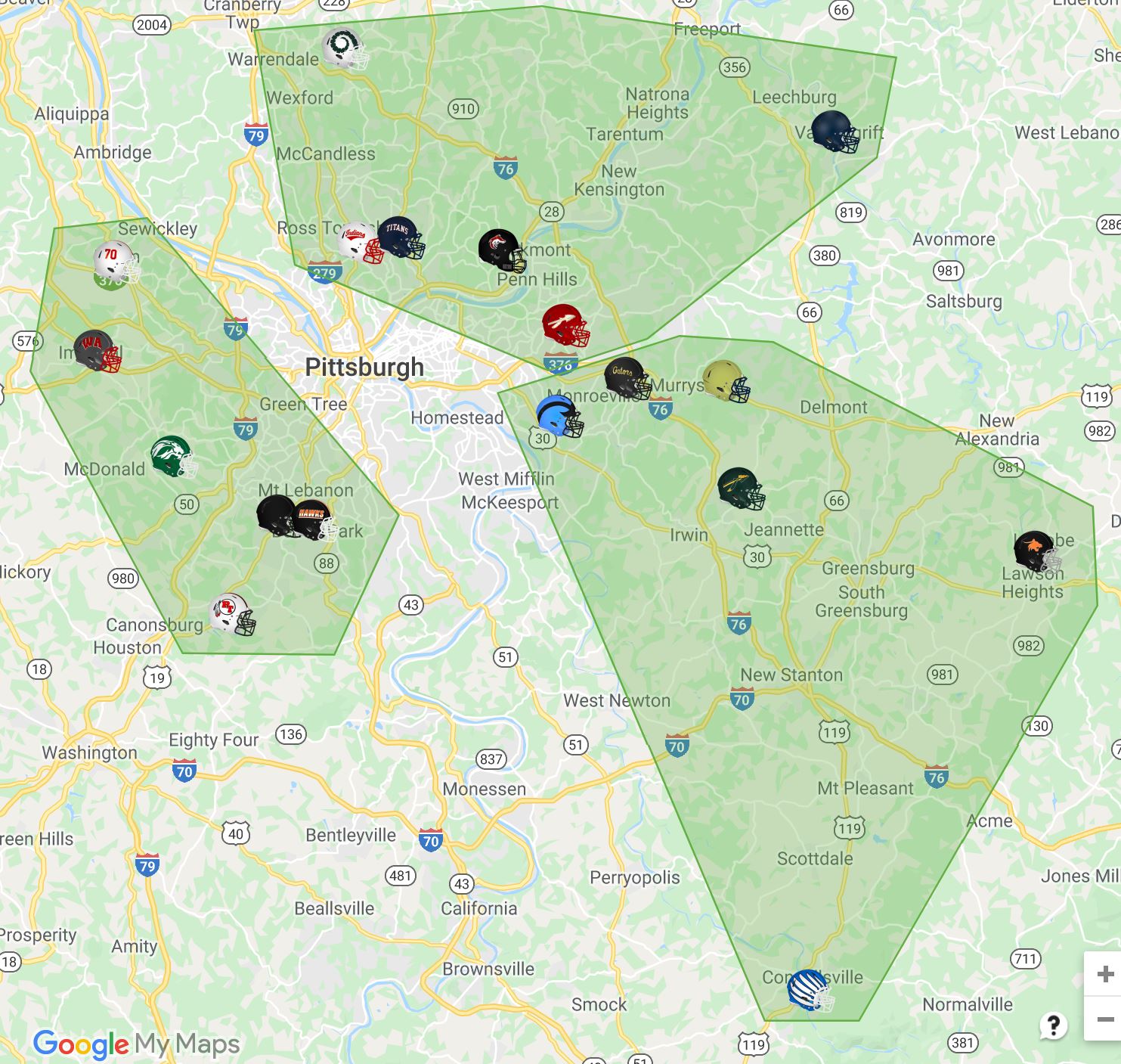 Shown here, a breakdown of the 18 5A teams into three conferences would have the following conference distribution:
Shown here, a breakdown of the 18 5A teams into three conferences would have the following conference distribution:
Great Southern: Bethel Park, Moon, Peters Twp, South Fayette, Upper St. Clair, West Allegheny
Greater Allegheny: Fox Chapel, Kiski, North Hills, Penn Hills, Pine-Richland, Shaler
Big East: Connellsville, Franklin Regional, Gateway, Latrobe, Penn-Trafford, Woodland Hills
If the WPIAL put these 18 teams into two conferences of 9 teams, there could be some lengthy travel situations including Connellsville to Moon or Latrobe to Pine-Richland. A breakdown with three groups of six makes the most sense.
5A + 6A Combination
The other option for the WPIAL to consider is to combine 5A and 6A teams. This could put some traditional rivalries (like Mt. Lebanon-Upper St Clair and North Allegheny-North Hills) back on the schedule as well as balancing schedules and conferences. Additionally, this could reduce travel time for all of the teams involved. This could serve as a beta test for the WPIAL to try out geographic conferences with teams from multiple classifications. My suggestion for combining 5A and 6A is to split the 9 6A teams evenly into 3 conferences. Those teams can be added to the three 5A conferences shown above to give each conference 9 total teams.
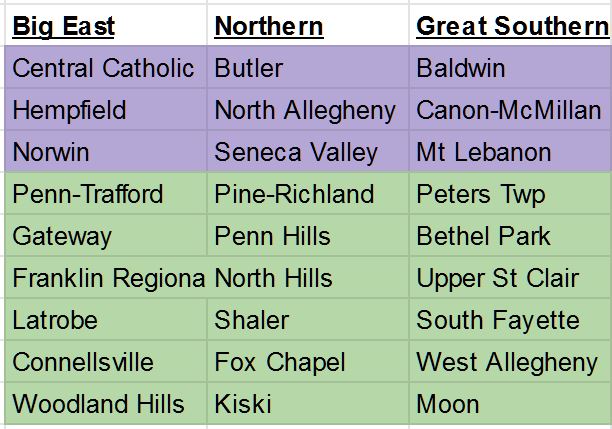 This alignment would help primarily with the scheduling of opponents. In my opinion, this combined 5A+6A approach is preferable to splitting the 18 5A teams into two conferences of 9 teams that have a greater geographic disparity. This approach would put several old geographic rivalries on the schedule (such as Penn-Trafford vs Norwin, North Allegheny vs North Hills, Baldwin vs Bethel Park, and Upper St Clair vs Mt Lebanon). While Central Catholic has recently played in a conference with the “Northern” teams including Pine-Richland and North Allegheny, the Vikings have in the past played with the Eastern schools (including Gateway and Woodland Hills) in the old AAAA Big East Conference. Geographically, Central may fit better in the North while Penn Hills may fit better in the East, but I wanted each conference to have an even split of 5A and 6A teams.
This alignment would help primarily with the scheduling of opponents. In my opinion, this combined 5A+6A approach is preferable to splitting the 18 5A teams into two conferences of 9 teams that have a greater geographic disparity. This approach would put several old geographic rivalries on the schedule (such as Penn-Trafford vs Norwin, North Allegheny vs North Hills, Baldwin vs Bethel Park, and Upper St Clair vs Mt Lebanon). While Central Catholic has recently played in a conference with the “Northern” teams including Pine-Richland and North Allegheny, the Vikings have in the past played with the Eastern schools (including Gateway and Woodland Hills) in the old AAAA Big East Conference. Geographically, Central may fit better in the North while Penn Hills may fit better in the East, but I wanted each conference to have an even split of 5A and 6A teams.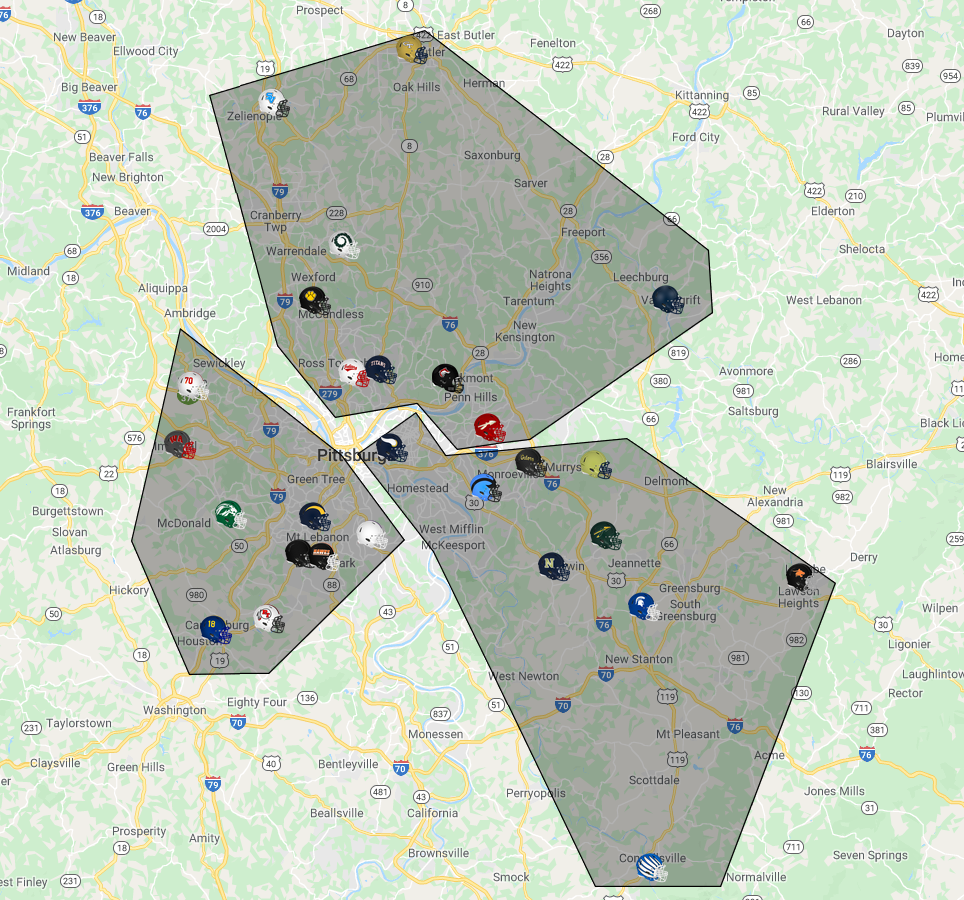
To determine playoff qualifiers from the combined 5A+6A classification, there are two potential options. The first would be to take the top teams and have a joint bracket based on the number of playoff weeks available before the teams would have to enter the PIAA playoffs. Alternatively, since there is an even distribution of 5A and 6A teams in each conference, a separated playoffs could be held where the top 2 6A teams from each conference would qualify (for a 6-team 6A playoff) and the top 5A teams from each conference would qualify for a separate 5A playoffs. For example, if the WPIAL 5A Champion entered the state playoffs at the semifinals, the top 4 5A teams from each conference could qualify for a 12-team playoff. Alternatively if the WPIAL 5A Champion entered the state playoffs at the quarterfinals, the top 2-3 5A teams from each conference could qualify for an 8-team 5A playoffs.
Class 4A
There will be 21 or 22 teams in 4A this cycle. Albert Gallatin’s enrollment would put them in 4A during this cycle, though there has not been an indication if they will continue to play as an independent or play a WPIAL schedule once again. In addition to Albert Gallatin, six teams will be moving down from 5A: McKeesport, Chartiers Valley, Mars, Hampton, Armstrong, and Plum. With 21 teams, the most sensible distribution is for 3 conferences of 7 teams.
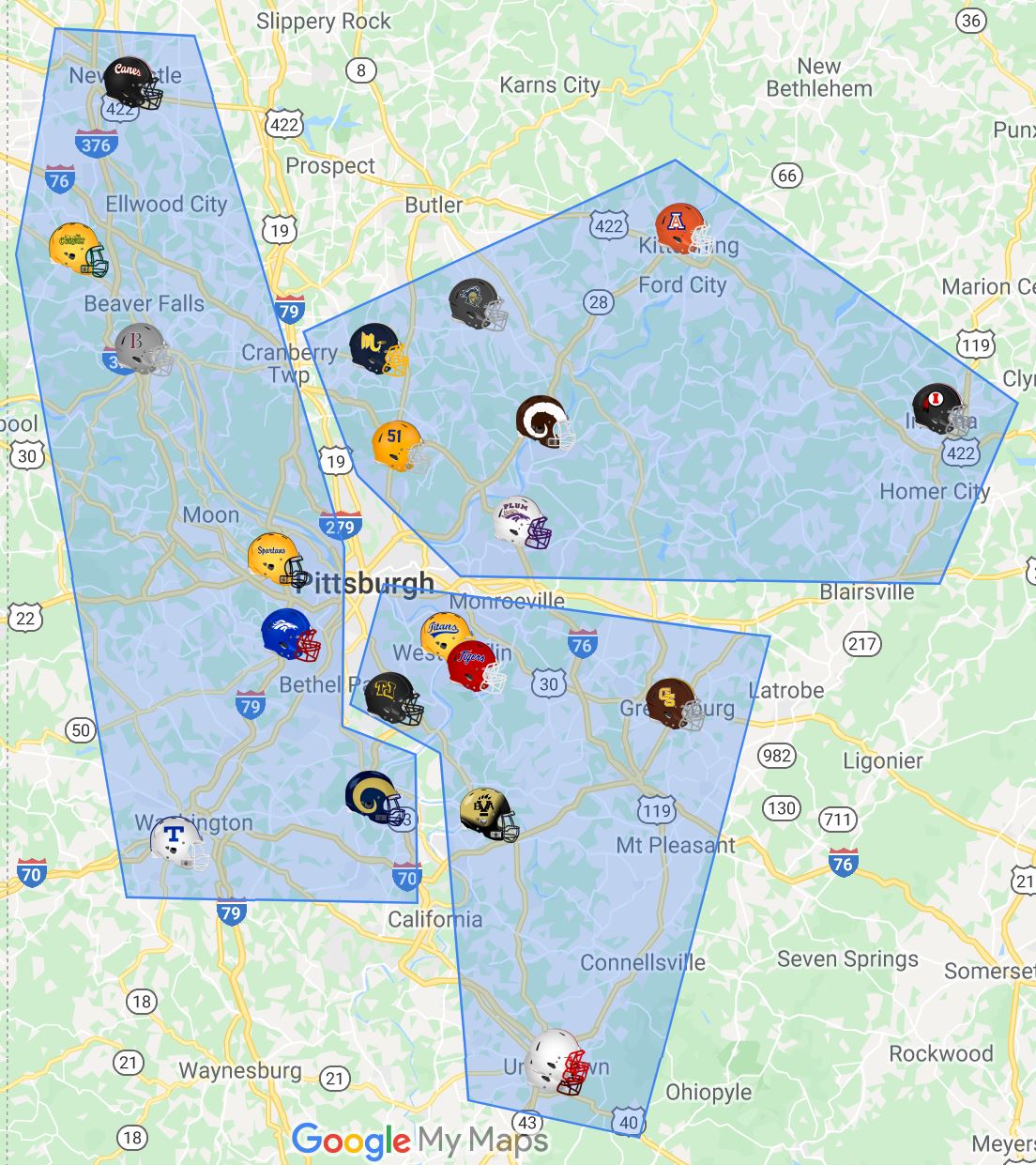 Geographically, there is not a great way to split the 4A teams into three conferences. Ideally, Thomas Jefferson, Belle Vernon and McKeesport would not be slotted into the same conference together. However, due to their proximity, it is difficult to separate them. Furthermore, I did not want to split up Thomas Jefferson from their rivals West Mifflin and Belle Vernon. The “Big Eight” conference with Uniontown and Laurel Highlands could easily accommodate Albert Gallatin if the Colonials return to the WPIAL.
Geographically, there is not a great way to split the 4A teams into three conferences. Ideally, Thomas Jefferson, Belle Vernon and McKeesport would not be slotted into the same conference together. However, due to their proximity, it is difficult to separate them. Furthermore, I did not want to split up Thomas Jefferson from their rivals West Mifflin and Belle Vernon. The “Big Eight” conference with Uniontown and Laurel Highlands could easily accommodate Albert Gallatin if the Colonials return to the WPIAL.
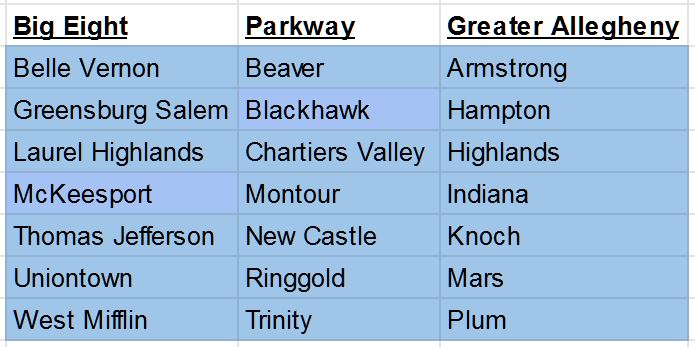 If the WPIAL did want to separate Thomas Jefferson from McKeesport and Belle Vernon, they could move TJ to the Parkway Conference and put Ringgold back in the Big Eight. Three conferences is the right distribution for 4A, even if only eight teams make the WPIAL playoffs.
If the WPIAL did want to separate Thomas Jefferson from McKeesport and Belle Vernon, they could move TJ to the Parkway Conference and put Ringgold back in the Big Eight. Three conferences is the right distribution for 4A, even if only eight teams make the WPIAL playoffs.
UPDATE: The PIAA informed Aliquippa that they will be forced to play up in 4A because of the new competitive balance rule. Aliquippa is expected to appeal. If the Quips appeal is denied and they have to play in 4A this cycle, Aliquippa could play in the Parkway with Ringgold moving back to the Big Eight. This would be a geographic benefit to both schools. Here is an updated map with Ringgold moved to the Big Eight and Aliquippa in the Parkway.
If only 8 4A teams make the playoffs, a head-to-head game between Parkway and Greater Allegheny teams could count towards the Wild Card formula.
Class 3A
Aliquippa has reached the 3A Championship Game in 12 straight seasons and had planned to once again play up in 3A this cycle.
Update: However, a recent PIAA ruling would force the Quips to move up to 4A, pending an appeal. The first part of this section covers the scenario of the Quips playing in 3A, the second in 4A.
Aliquippa in 3A
A number of teams will be moving up from 2A to 3A this cycle, including defending 2A Champions Avonworth, Southmoreland who made the playoffs for the first time since 1979, East Allegheny, South Allegheny, Brownsville, and Valley. With 21 teams, 3A splits relatively easily into three conferences with 7 teams each.
Geographically, the five teams in the Beaver Valley (Central Valley, Aliquippa, Hopewell, Ambridge, Quaker Valley) are natural inclusions into the same conference. The choice will be who the other two teams are in that grouping. Last cycle, the WPIAL separated North Catholic from the Beaver Valley teams but included Keystone Oaks and South Park. WPIAL may opt to put North Catholic and Avonworth in the Beaver Valley Conference instead of Keystone Oaks and South Park, which could shift things around slightly. Similarly, the Allegheny Valley teams (Freeport, Deer Lakes, Valley, and Burrell) should all be grouped together. East Allegheny and Valley both played in the 2A Allegheny Conference last year.
Aliquippa in 4A
If Aliquippa is in 4A, they could slot into the 4A Parkway Conference as noted above. The WPIAL could keep the distribution of 3A the same as proposed with 3 conferences where the Beaver Valley would have 6 teams and the Big East and Interstate would both have 7 teams. This would be the same as the chart above, just without Aliquippa. The other option, with 20 teams in 3A, would be to consolidate into two conferences with 10 teams each. Last cycle, the WPIAL aligned the two conferences based on an East-West split rather than the more travel-friendly North-South split. The North-South split would work perfectly this cycle, if the WPIAL decided on just two conferences. Here is how the North-South breakdown would look.
In the North the trip from Freeport to Central Valley is about 40 miles, which would be a vast improvement over the longest trip both schools had to make with the East-West divide last cycle. Central Valley had to travel to Waynesburg and Freeport had to travel to Uniontown (both trips of 70 miles). The longest trips in the South would be from Derry to Brownsville (50 miles), Derry to Keystone Oaks (45 miles), and Brownsville to Keystone Oaks (40 miles).
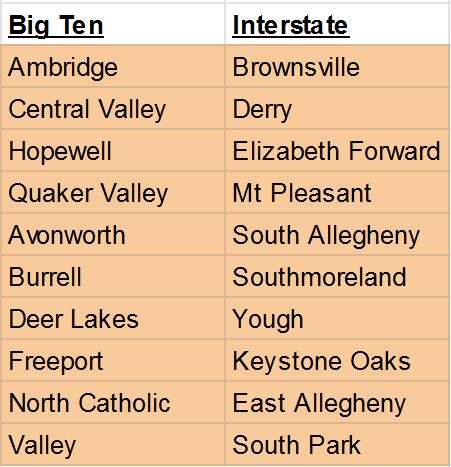 The one downside of two conferences with 10 teams each is that their entire 9-week regular season schedule would be filled with conference games. The only non-conference game available to these teams would be in Week 0. The other problem this could create is with the entire 9-week schedule filled with conference play in 3A, the scheduling of other classes would be imbalanced. Class 1A has an even-numbered 24 teams and can play a contained head-to-head schedule each week. However, 2A has 27 teams which means one 2A team per week will need to play a team from another classification. If 3A’s schedule is filled entirely with conference games, this means a 2A team would have to play against a 4A team every week. That is less than ideal, so a three-conference breakdown in 3A seems to be preferable to allow for a 2A vs 3A and then 3A vs 4A matchup each week.
The one downside of two conferences with 10 teams each is that their entire 9-week regular season schedule would be filled with conference games. The only non-conference game available to these teams would be in Week 0. The other problem this could create is with the entire 9-week schedule filled with conference play in 3A, the scheduling of other classes would be imbalanced. Class 1A has an even-numbered 24 teams and can play a contained head-to-head schedule each week. However, 2A has 27 teams which means one 2A team per week will need to play a team from another classification. If 3A’s schedule is filled entirely with conference games, this means a 2A team would have to play against a 4A team every week. That is less than ideal, so a three-conference breakdown in 3A seems to be preferable to allow for a 2A vs 3A and then 3A vs 4A matchup each week.
Class 2A
There will be a bit of a changeover this cycle in 2A as 6 teams are moving up to 3A, including defending Champions Avonworth. Beaver Falls, who won the 2016 WPIAL and PIAA 3A Championships will be moving down to 2A this cycle. Four teams from 2A will be moving down to 1A, including two-time Three Rivers Conference champions Burgettstown, while three teams are moving up from 1A, including Sto-Rox who recently made the WPIAL final. In total, there will be 27 2A teams this cycle.
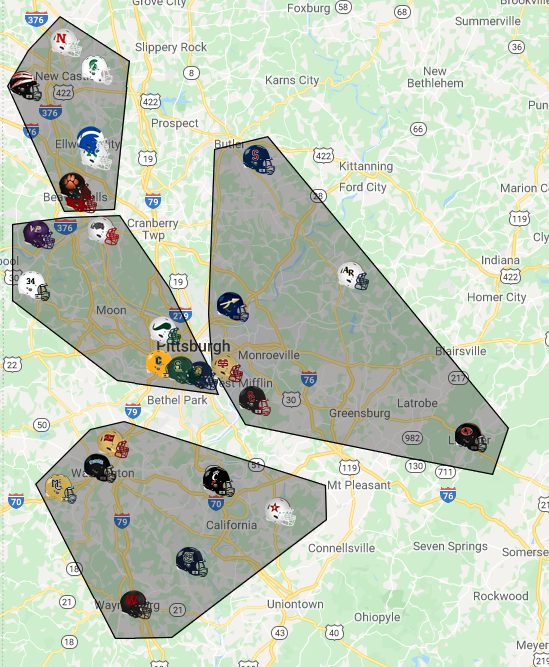 With 27 teams, they could be evenly split into three conferences of 9 teams each or stay with the current four conference alignment. Due to the side geographic split of some teams (like newly-joined Ligonier Valley and Apollo-Ridge), it seemed better to stick with the current breakdown of four conferences. Geographically, there are 10 teams located in Lawrence and Beaver Counties. To prevent a team like Apollo-Ridge, Ligonier Valley, or South Side Beaver from having a cumbersome travel schedule, I split the teams into four conferences instead of three.
With 27 teams, they could be evenly split into three conferences of 9 teams each or stay with the current four conference alignment. Due to the side geographic split of some teams (like newly-joined Ligonier Valley and Apollo-Ridge), it seemed better to stick with the current breakdown of four conferences. Geographically, there are 10 teams located in Lawrence and Beaver Counties. To prevent a team like Apollo-Ridge, Ligonier Valley, or South Side Beaver from having a cumbersome travel schedule, I split the teams into four conferences instead of three.
While there are still some long travel distances in the Allegheny Conference, Apollo-Ridge and Ligonier Valley are both Westmoreland County schools (the only ones in 2A). Steel Valley, Summit Academy, and Shady Side Academy were conference opponents with Apollo-Ridge last cycle so this is not a major change. Of the Lawrence/Beaver County schools, the northern-most seven were placed in the Midwestern Conference.
Class 1A
The alignment for 1A this cycle should be relatively simple. With 3 teams moving up to 2A and 4 teams moving down, there will be 21 teams. Fortunately, these teams should slot in to the current geographic alignments in 1A with relative ease.
The Tri-County South loses Chartiers-Houston to 2A but adds back Carmichaels, who fits perfectly within the geographic footprint of the conference. Laurel and Sto-Rox are moving up from the Big Seven Conference, while Shenango is moving down. The other two additions are Burgettstown and Fort Cherry. There would be too many teams to slot them in the Tri-County South and putting them in the Eastern Conference would make for a cumbersome travel to Leechburg, Jeannette, and Greensburg Central Catholic. Therefore, it makes the most sense to slot Burgettstown and Fort Cherry in the Big Seven Conference. The only decision left to balance out the conference would be to move either Northgate or Bishop Canevin to the Eastern Conference. I decided on Bishop Canevin as they have played in the Eastern Conference previously.
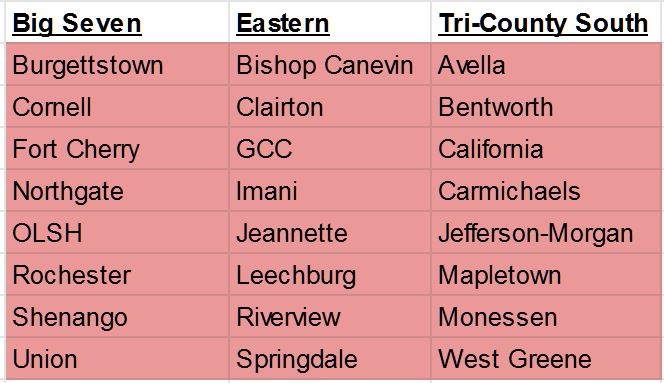 Conclusion
Conclusion
In conclusion, these are only recommendations based on the current status quo of aligning teams by enrollment classifications then splitting them into conferences. It is possible that the WPIAL could pursue a different alignment based on regions and geography while putting teams from multiple classifications into the same conference. This is a practice in other districts around the state that do not have enough teams in a single classification for a 9-game schedule. That said, if the WPIAL wanted to test out conferences with teams from multiple classifications without shaking up the entire slate, using a combined 5A + 6A alignment could provide a good test run as well as having scheduling benefits. With 21 teams in 4A, 3A, and 1A, those three classifications should be relatively easy to align. (UPDATE: If Aliquippa’s appeal is unsuccessful and they stay in 4A, it will be 22 4A teams and 20 3A teams.)
The biggest decisions will be what to do in 5A and 2A. Though the WPIAL has typically favored fewer conferences with more teams in each section, for geographic purposes both 5A and 2A would be better served with more conferences this cycle to cut down on cumbersome travel schedules. I will admit that I am intrigued by the combined 5A + 6A alignment and hope that the WPIAL gives it consideration as they structure the conference alignments for this cycle.


